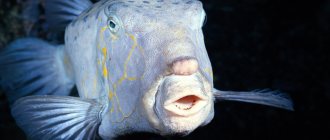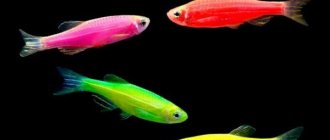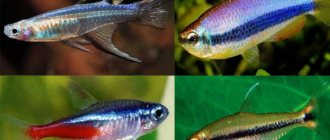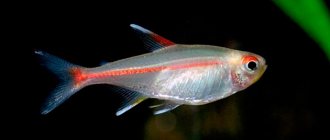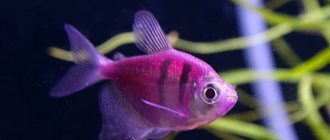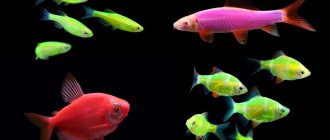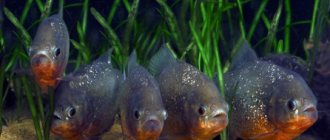Representatives of the zebrafish species (Danio rerio) are well known to many aquarists. After all, these are one of the most popular fish suitable for keeping in a community aquarium. They are popular, first of all, for their beauty, endurance, activity and small size, reaching a length of only 6 cm. The first representatives of this species, described by Hamilton in 1822, had a slender, laterally compressed silvery body, with five dark blue horizontal stripes , which extended from the gills to the end of the caudal fin. There were even horizontal blue stripes on the dorsal and anal fins, making these fish brightly colored. Usually they did not grow more than 5 cm in length. By the way, zebrafish can be bought in this section https://marlin-shop.ru/category/tetry-rasbory-danio/
Danio rerio ( Danio rerio )
Zebrafish can withstand a wide range of water parameters and are well adapted to life in an aquarium, where they have a lifespan of up to three years. These are active, sociable fish that love to interact with other members of their species. Therefore, it is better to keep them in a flock so that they do not get bored. Life within the pack is intense: quarrels break out between individuals every now and then, which often end in crazy chases. However, it is rare that these fish cause any harm to each other. As a rule, a certain hierarchy is established among them, where the largest fish (often a female) dominates over everyone. All these internal disassemblies and continuous movement around the aquarium make zebrafish very interesting objects for observation.
They are widespread in India, Pakistan, Bangladesh and Burma, where their range of habitats varies markedly, ranging from slow-moving rivers to flooded rice fields. However, most aquarium representatives of zebrafish were raised on farms. Man-made breeds include spotted leopard danios (also known as Danio frankei), golden zebrafish with vague stripes, and long-finned varieties that can be particularly attractive. Since zebrafish are easy to breed, they have been used in laboratory scientific experiments. Some zebrafish have even been transfected with sea anemone genes that make them glow fluorescent red.
Representatives of this species belong to the Cyprinidae family, which includes the well-known carps and minnows. The Cyprinidae family is very large, with more than 200 genera and more than 2000 species. Some characteristic features of this family are the teeth, which are located not in the jaw, but in the pharynx (pharyngeal teeth), while some species also have antennae (the zebrafish has two pairs of them).
Variations of zebrafish with long fins can look very attractive
Danio rerio belongs to the subfamily Danioninae, which contains several genera, including Danio (Hamilton, 1822) and Devario (Heckel, 1843). The latter contain many dani-like tropical fish.
The zebrafish was originally classified in the genus Brachydanio, but that genus no longer exists. Danio rerio, along with other species, were moved to the genus Danio. The characteristic features of this genus are horizontal stripes and long antennae, while the stripes of representatives of the genus Devario are most often transverse, and they themselves lack antennae (if they do exist, they are very short, rudimentary).
Habitat
The homeland of zebrafish is Southeast and Central Asia. These fish live in freshwater bodies of Pakistan, Indonesia, Bhutan, India and Nepal. They live in flocks and with the onset of the rainy season they move to puddles and flooded rice fields. There they reproduce and forage for food.
At the end of the rainy period, the fish return to rivers, canals, ponds and other deep-sea bodies of water.
Appearance and gender differences
The translucent body of the fish is laterally flattened and elongated. A pair of long whiskers is located on the head of a blue zebrafish. The body is golden-red in color, its main color is gray-blue. The fish's belly is slightly bluish. When mating season begins, the body color of Kerr's zebrafish becomes brighter. The eyes are surrounded by a golden border. Two stripes start on the side of the eyes; they are golden. They stretch all the way to the tail. The fins of the fish are transparent and have a slight greenish or yellowish tint. The body length of the Kerr zebrafish reaches 5 cm.
The differences between the sexes lie in the brightness of the color. Females are more faded, males are slender, small and bright.
Description
Danio rerio is a cute miniature fish from the Cyprinidae family, growing up to 6 cm long. It has an elongated narrow body and an expressive head with a slightly upturned nose.
The fish has a characteristic “zebra” color, which performs not only decorative, but also camouflage functions. There are longitudinal blue stripes on her body, stretching from head to tail. There is a zebra print on the caudal and anal fins. The remaining fins are short, almost transparent.
Interesting! Because of the longitudinal stripes on their narrow, slender body, zebrafish have earned the nickname "zebra danio" or "ladies' stocking."
Varieties of zebrafish
The genus boasts a wide variety of species. Breeders also contributed to the popularity of the fish, producing many hybrids with delightful colors.
Veiled
The main feature of the species is the elongated transparent fins. Not only rerio, but also other hybrids can boast of such decoration.
Leopard zebrafish
Everything about the color features of these fish is clear from the name. Breeders turned the horizontal blue stripes into spots that decorated the entire body of the fish.
Glofish
Scientists obtained the Glofish color rainbow by genetically modifying rerio.
The implanted genes made it possible to create a species whose individuals can be colored red, green, blue, orange and purple.
Moreover, they all reproduce successfully.
Rerio
Rerio is a miniature zebra of the underwater world. Blue stripes running from head to tail not only decorate the fish, but also act as a protective camouflage. Maximum body length is 6 cm.
Devario Malabaricus
We can say about the Malabar zebrafish that it is the largest (up to 10 cm in length) representative of the species.
Blue stripes are clearly visible on its body, separated by a golden color, which also appears in the transverse strokes behind the gills.
The widest stripe in males is located in the middle, and in females it extends to the upper part of the tail.
Dangila
A large species of zebrafish with a body length of up to 10 cm, colored in olive tones. There is a noticeable black spot near the gills.
Prone to aggression, the school is capable of attacking fish much larger than them in size.
orangefin
Small, up to 5 cm, fish, the dotted pattern of the body is complemented by an orange border of fins. Males have a brighter border.
Firefly, or chopra
A natural species of zebrafish that lives in the rivers of Myanmar. Its dimensions are small, no more than 3 cm in length.
Along the silver-olive background of the body there is a red longitudinal luminous stripe, under it there are dark transverse strokes located closer to the tail.
Females have a yellow main stripe. People call the fish a firefly.
Erythromicron
Another miniature zebrafish. The body length of erythromicron is only 3 cm.
The main color is pink-orange, complemented by transverse emerald stripes and an expressive dark spot at the tail, framed by a golden halo.
It has a timid character and requires the installation of shelters when kept in an aquarium.
Burmese
The bluish body of the Burmese zebrafish is decorated with chaotically scattered golden spots.
It also has another noticeable yellow-orange spot, located immediately behind the gills.
Males are distinguished from females by stripes on their fins: white for girls, orange for boys.
Bengal
Long, up to 8 cm, fish with a silver body color. The restraint of color is complemented by transverse yellow strokes.
They have a long dorsal fin, and the upper lobe of the tail is colored blue.
Kerry blue
The Kerry has an olive-blue body, lined with two luminous pink stripes. The coloring of males is brighter than that of females.
Spot
The color of this species combines rerio and leopard. The upper half of the fish’s body is lined with blue horizontal stripes, and dark spots are scattered below.
Spot zebrafish love warm water (not lower than 24 °C), their body length is 4 cm. Males and females differ in the color of their abdomen: white and orange.
Pearl
In the front part the body of the fish is transparent, and closer to the tail it acquires a bluish tint.
It is named pearl because of the pearlescent tints that appear in certain lighting.
A thin orange stripe is clearly visible on a blue background. The fins are cast in a red or green tone. The length of the fish is 5.5 cm.
Pink
Despite the name, many aquarists call this species coral. The fish was bred artificially.
In addition to the pink-coral background, there are longitudinal white stripes on her body. The length for zebrafish is average, approximately 4.5 cm.
Margaritatus
The fish has a second, very beautiful name - microrasbora galaxy. One of the original painted species:
- the dark body is decorated with a scattering of golden spots;
- the fins are bright orange, with a black edging along the edge;
- There is a golden stripe on the back.
1
Attention! They like to live in large flocks.
Maintenance and care
Danio rerio is an unpretentious and hardy fish that even a novice aquarist can handle keeping. The main thing is to provide them with adequate feeding and suitable conditions.
Aquarium
Danio rerio are schooling fish and it is recommended to keep them in groups of 5-6 individuals. It is important that for every male there are a pair of females. The volume of the aquarium for a “family” of 5 zebrafish should be at least 30 liters. And when adding other fish, the size of the tank will have to be increased in proportion to the dimensions and number of individuals.
Since zebrafish scurry briskly in the upper and middle layers of water, moving with fast linear movements, it is better to populate them not in a round, but in a high rectangular aquarium. And since fish can jump out of the water, it is better to cover the tank with a lid.
Water
Danio rerio are very demanding on water quality. It must be clean and meet the following parameters:
- temperature – 17-25 0C;
- acidity – 6.7-7.0;
- hardness – 6-15.
Danio rerio needs regular water changes - 25-30% of the total volume. Without them, it is impossible to maintain the cleanliness of the aquatic environment and the fish will simply die.
Equipment
Danio rerio live in clean water enriched with oxygen. Therefore, the aquarium for them needs to be supplemented with a filter, the performance of which is selected taking into account the size of the tank. And since zebrafish love flow and enjoy frolicking in air bubbles, the container can be equipped with an aerator.
Soil and plants
The bottom of an aquarium with zebrafish can be covered with crushed granite, sand and small pebbles. When choosing a substrate, it is worth considering that these fish look most impressive against a dark background.
Danio rerio are active creatures, constantly on the move. The fish's favorite pastime is playing catch-up, so they need room to maneuver. To avoid cluttering the aquarium with plants, it is better to plant them along the back wall of the tank.
It is recommended to give preference to long-leaved species, such as myriophyllum, saggitaria and vallisneria. But if desired, you can add floating greenery to the aquarium. The main thing is that it does not interfere with the movement of the fish.
Motherland
The birthplace of everyone's favorite Danio rerio is Asia. They can be found in large numbers in natural bodies of water stretching from Pakistan to India. Small populations of fish can also be found in the rivers of Bhutan, Bangladesh and Nepal.
Rerio was first described by Hamilton, who visited Asian countries in 1822 and became acquainted with this amazing representative of the local fauna.
Compatibility
Danio rerio have a peaceful disposition and get along well with representatives of many other species. Good neighbors for these fish will be guppies, bettas, neons, angelfish, lalius, speckled catfish, ancistrus, mollies, swordtails, platies, cardinals, rasboras, snails and shrimp.
You cannot place zebrafish in the same aquarium with tetraodons, cichlids, macropods, thorns, barbs, cold-water fish and goldfish. Almost all of them behave aggressively and attack smaller individuals. And some of them are also incompatible with zebrafish due to different requirements for the parameters of the aquatic environment.
Aquarium
It can be kept in a community aquarium that is closed at the top, in which, along with plants, there should be enough free space for swimming.
Danio rerio (Danio) in an aquarium.
Water parameters (optimal):
Temperature: 23 - 25° C pH: 6.0 - 7.5 Hardness: 5 - 15° dGH
Active filtration with aeration and weekly replacement of a third of the water with fresh water are required.
Feeding
Danio rerio is an omnivorous species. In their natural habitat, they eat seeds, small insects and their larvae floating in the upper and middle layers of water with equal appetite.
When kept at home, these fish can be given live, frozen and dry food. Pets' diet should include larvae, tubifex flies, fruit flies, brine shrimp, greens, bloodworms and daphnia.
For dry food, zebrafish can be fed TetraMin flakes. They stay on the water for quite a long time, and then begin to slowly sink to the bottom. TetraMin flakes contain more than 40 quality ingredients, making them suitable for daily feeding of aquarium fish. And the prebiotics present in their composition have a positive effect on the functioning of the gastrointestinal tract.
Zebrafish can also be fed with floating sticks or pellets from the MicroFood series. Their small size is well suited for the small mouth openings of fish. And the high buoyancy of the food allows it to stay on the surface of the water for a long time.
Since zebrafish prefer to search for food in the upper and middle layers of water, they need to be fed in small portions. Otherwise, food debris will settle to the bottom and begin to rot. Adult fish are fed once a day and are given fasting days weekly. Young animals need two meals a day.
Social behavior
Blue Danio requires being kept together in a group of at least 5 individuals; with a smaller number, lethargy and faded coloring may occur, and if alone, the fish will die. Excellent neighbors are other representatives of Danio, as well as other active and peaceful species of small size. Long fins can be tempting to some species, particularly barbs, which will instinctively bite them, causing injury. Therefore, before purchasing aquarium mates, check to see if your new pets have a similar behavioral feature.
Features of reproduction
Danio rerio is easy not only to keep, but also to breed. The fish reach sexual maturity at 4-6 months and reproduce regardless of the season.
Sex differences
Zebrafish do not have very well expressed sexual dimorphism. But if you look closely, you will notice that the male is slightly different from the female:
- Body type and size. Males look slimmer and are about 5 mm shorter than females. Females are denser in the abdominal area and appear larger than male fish.
- Color, or rather its saturation. Males have bright colors with rich stripes. Females are forced to hide during spawning, so their bodies are painted in more subdued tones.
- Anal fin. In females it is rounded, in males it is pointed. But this feature is not always clearly expressed and it is erroneous to determine the sex of zebrafish based only on the shape of the anal fin.
- Behavior. Females behave slower and calmer than dynamic and fast males.
Preparing for spawning
Future breeders are placed in separate 10-liter aquariums and provided with high-protein food, such as bloodworms or daphnia, for several days. The readiness of the female for spawning can be judged by the changed shape of the abdomen. Her tummy becomes convex not only in front, but also at the anal fin.
Spawning
A 30-liter aquarium is suitable as a spawning ground for zebrafish. Small-leaved plants can be placed in it, but it is better to discard the soil, since without it it will be easier to monitor the throwing and development of eggs. To prevent producers from getting to the eggs, a grate can be placed at the bottom of the spawning tank.
A suitable tank is filled with water, the level of which should not exceed 6-10 cm, and placed closer to the window. Towards evening, a female and 2-3 males are released into the prepared aquarium.
Spawning in zebrafish lasts about an hour and during this time the female manages to lay about 400 eggs. The males chase the partner and hit her abdomen to knock out the eggs, and then fertilize her with milk.
On a note. If the female does not respond to males and tries to hide, it means she is not ready to spawn. In this case, it is moved into a separate aquarium and the eggs are waited for maturation. If the males are not interested in the female, they are transplanted into a tank with warm water and heavily fed. When they begin to catch up with each other, they are placed with a female.
Care of offspring
The rate at which eggs ripen depends on the microclimate in the spawning area. At a water temperature of 25-28 0C, this process takes 2-3 days. At 16 0C, the eggs mature within 7-9 days.
The hatching fry attach themselves to the walls of the aquarium or aquatic plants and remain in this position until the yolk sac is completely reabsorbed. The basis of the diet of small zebrafish should be ciliates, live finger and dry food for fry, like TetraMin Baby.
With proper nutrition and comfortable parameters of the aquatic environment, the fish grow very quickly and reach normal sizes in 2-3 months.
Breeding
Before landing for spawning, males and females are kept separately for 7-10 days and well fed with live food. You can plant a pair for spawning, but it is better to have 2 males and 1 female or a group of fish with a predominance of males.
Spawning aquarium from 30 liters per pair of fish with a separator net and small-leaved plants. The water is fresh, with the same parameters as when kept, the level is 8-10 cm. The fish are planted in the evening and the temperature is raised by 2-3°C.
Spawning usually occurs in the morning at sunrise or when the lights turn on. After spawning, the fish are removed, the net and plants are removed after shaking off the eggs.
Danio (Danio) larvae/fry of different species.
The incubation period is 2-5 days, the fry swim in 3-7 days. Starter food: live dust - ciliates, rotifers.
The average life expectancy is about 3-4 years.
Health and life expectancy
Under favorable conditions, zebrafish live for about 3-5 years. Unbalanced feeding and keeping fish in dirty water can lead to the development of the following diseases:
- Obesity. The pathology develops as a result of overeating caused by heavy feeding. The fish quickly gain weight and become inactive. To prevent obesity, zebrafish are provided with a balanced diet and fed without exceeding the recommended norms.
- Bug-eyed. A dangerous disease that is difficult to diagnose at an early stage. It develops against the background of keeping fish in dirty water and progresses quickly. If a sick individual is not given timely assistance, it will die.
- Alkaline disease (alkalosis). Pathology occurs when the acid-base balance of the aquatic environment is disturbed and is treated by restoring the pH. Affected fish turn pale, try to jump out of the aquarium and itch on hard surfaces.
- Trichodinosis. The causative agent of the disease is the trichodina ciliate, which rapidly multiplies in dirty water. Infected fish turn pale, become covered with a dirty coating and itch against the walls of the aquarium. Trichodinosis is treated with salt baths and a temporary increase in water temperature to 30 0C.
- Mycobacteriosis (tuberculosis). The causative agent of the disease enters the aquarium with infected fish, poorly washed plants or dirty soil. Infected individuals become lethargic, refuse to feed and lose their scales. In the early stages, mycobacteriosis is treated with kanimycin. in advanced cases, therapy is not effective and the fish dies.
Danio rerio is a striped, nimble fish with an energetic temperament and a peaceful disposition. They do not require labor-intensive care and will decorate any aquarium.
Diseases
An attentive and caring aquarist must be prepared for the fact that his beloved pets may suddenly become ill. The following diseases are typical for zebrafish:
- Plistophorosis is a disease that manifests itself in the form of light spots on the body of the fish, which over time turn into ulcers. The fins begin to ruffle, the fish move in an unusual way and refuse to eat. To cure pets, use Trichopolum or Erythrocycline, the aquarium, soil and decorations are disinfected.
- Trichodinosis - ciliates are considered the source of the disease. Symptoms of trichodinosis appear in the form of gray flakes on the body of fish, pets begin to rub against walls and decorations. To save the phenotypes, table salt is added to the water, the temperature is raised to 30C, and aeration is increased. If the fish become worse, the infected individuals are destroyed, and the remaining pets are quarantined.
Danio is a genus of fish with many varieties of different colors and sizes, among which every aquarist will find a pet to their liking. Having acquired a flock of bright and active fish, you should follow the rules of care and maintenance of the phenotypes in order to eliminate the likelihood of developing diseases.
Difficulty in content
These unpretentious and beautiful aquarium fish are great for beginners.
They are very easy to breed and the fry are not difficult to feed.
Since this is a schooling fish, you need to keep at least 5 of them in the aquarium, preferably more. They will get along with any peaceful and medium-sized fish.
Danio rerio eats any food you offer it. They tolerate very different water parameters very well and can live even without heating the water.
And yet, although they are very hardy, they should not be kept in extreme conditions.
By the way, don’t be surprised if you see that a school of zebrafish spends a lot of time near the filter, where the current in the aquarium is strongest.
They simply love the flow, as in nature they live in streams and rivers.
The Danio Rerio fish should be placed in an aquarium whose length is significantly greater than its height, since it loves to chase its own kind. If you purchase a flock consisting of 10–20 individuals, then for a normal life a container with a volume of 30–70 liters will be enough for them.
In the event that the population begins to actively increase, the owners will have to change the aquarium to a more spacious one. When arranging it, you should use floating plants or those planted in the ground, then they can always hide from annoying relatives.
It is recommended to keep the rerio at a temperature of 18–23 degrees; up to 30% of the water should be updated weekly. Due to the fact that such fish often jump out of aquariums, many owners cover them with lids. But at the same time they should leave a small gap through which air will flow.


